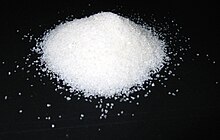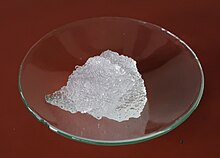Superabsorbents
Superabsorbents (Superabsorbent Polymers, SAP) are called plastics that are able to absorb polar liquids many times their own weight. These are mainly water or aqueous solutions.
When the liquid is absorbed, the superabsorbent swells and forms a hydrogel . The sum of the volume of the liquid and the volume of the dry superabsorbent remains the same.
The more recent research in the field of materials science now also enables the production of superabsorbents for oil. These can absorb up to 45 times their own weight in oil. The affinity for oil is brought about by the aliphatic and aromatic side chains of the base polymer.
use
The product is used as a white granulate with particle sizes of 100… 1,000 µm. It is mostly used in baby diapers , sanitary napkins , in incontinence care , in bandages and, in small quantities, in cable sheathing for deep-sea lines . However, other applications are also gradually establishing themselves, such as in so-called gel beds (see water bed ), as gel-forming extinguishing agents in fire-fighting, as a mechanical stabilizer for cut flowers in a vase or as an additive for potting soil to permanently store water. However, acrylic acid neutralized with potassium hydroxide is used here because it is more environmentally friendly. Large manufacturers of superabsorbents include BASF SE , Evonik , and Nippon Shokubai . Large superabsorbents are z. B. Procter & Gamble , Kimberly-Clark , Attends Healthcare Europe ( Domtar Group) or SCA , in Germany Paul Hartmann AG and the company Ontex.
To increase the water storage capacity in soils, water storage granules (e.g. a cross-linked copolymer based on potassium salt ) have been used in horticulture , especially in urban greening , for a number of years . Investigations into the mode of action and the whereabouts of superabsorbents introduced into the soil by horticulture were carried out with the assistance of the Justus Liebig University in Giessen . In addition to composite granules, which consist of a highly porous mineral matrix and hydrogel polymers attached to it, research is also being carried out into the alternative production of superabsorbents from starch as a renewable raw material for global use in the agricultural sector.
composition
Hydrogels can form all crosslinked polymers that are polar (e.g. polyacrylamide , polyvinylpyrrolidone , amylopectin , gelatin , cellulose ).
Usually, however, a copolymer of acrylic acid (propenoic acid, H 2 C = CH-COOH) or sodium acrylate (sodium salt of acrylic acid, H 2 C = CH-COONa) on the one hand and acrylamide on the other hand is used, whereby the ratio of the two monomers to one another can vary.
In addition, a so-called core cross-linker (CXL) is added to the monomer solution, which connects the long-chain polymer molecules formed with one another in places by means of chemical bridges ( cross-links ). These bridges make the polymer insoluble in water. This so-called base polymer may be subjected to what is known as surface cross-linking (SXL). Another chemical is applied to the surface of the particle, which, when heated, creates a second network only on the outer layer of the grain. This cover supports the swollen gel in order to hold together even under external stress (movement, pressure).
functionality
Polar polymers like pure polyacrylic acid already bind large amounts of the polar water (1000 times its mass) inside and swell in the process.
Due to the sodium ions within the polymer structure, the molecule also develops a strong salt character, and further liquid absorption occurs due to an osmotic pressure .
This osmotic pressure ultimately determines the absorption capacity of the superabsorbent.
This results in the following relationships: The more sodium ions are built into the polymer, the greater the amount of liquid that can be absorbed. The higher the concentration of salts in the liquid, the lower the absorption will be. This explains that pure water is absorbed in the order of several hundred times the weight of the superabsorbent, whereas saline solutions - e.g. B. Urine - significantly limit the capacity of the superabsorbent. A physiological saline solution only binds 100 times as much.
Within the particle, the liquid tries to dissolve the molecule, which is like a salt - in this case, to separate the sodium from the anion residue. The sodium actually dissolves in the liquid and forms a hydrate shell around itself due to its electrical charge ( Na + ) and the dipole character of the water .
The organic residue, however, is insoluble in water due to its polymer structure and in particular due to the crosslinking. In the places where sodium ions were still found in the dry state, vacant places with a negative charge now remain open. Hydrate shells also form there, but they do not compensate for the charge imbalance. Since these vacant spots in the polymer chain can appear next to each other and the same charges repel each other, the molecule is stretched wider and wider in order to achieve the greatest possible distance between them. This is clearly visible when swelling during absorption.
literature
- Frederic L. Buchholz, Andrew T. Graham (Eds.): Modern Superabsorbent Polymer Technology . Wiley-VCH, New York 1998, ISBN 0-471-19411-5 (English).
- Michael Zeuke: Superabsorbents made from renewable raw materials. The targeted synthesis with renewable raw materials. In: CHEMKON. Vol. 12, No. 4, 2005, doi : 10.1002 / ckon.200510029 , pp. 155-159.
Web links
Individual evidence
- ^ Yuan, X., & Chung, TM (2012). Novel solution to oil spill recovery: using thermodegradable polyolefin oil superabsorbent polymer (oil-SAP). Energy & Fuels, 26 (8), 4896-4902
- ↑ STOCKOSORB® a product from GEFA Produkte Fabritz GmbH.
- ↑ How great is the superabsorbent? An innovative detection method for the degradation of soil additives Spiegel der Forschungs; 27, 2 special issue: Top Research; 76-81; Year of publication: 2010; ISSN 0176-3008
- ↑ MD Lechner, W. Lazik: Superabsorbents from renewable raw materials: synthesis, properties, application , In: Series of renewable raw materials 18, 2001, 205–215.
- ↑ http://www.chemgapedia.de/vsengine/vlu/vsc/de/ch/9/mac/funktionspolymere/superabsorber/superabsorber.vlu.html Superabsorber on Chemgapedia.
- ↑ a b http://www.chemgapedia.de/vsengine/vlu/vsc/de/ch/9/mac/funktionspolymere/superabsorber/superabsorber.vlu/Page/vsc/de/ch/9/mac/funktionspolymere/superabsorber / polyacrylic acid.vscml.html

